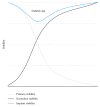Impact of Dental Implant Surface Modifications on Osseointegration
- PMID: 27478833
- PMCID: PMC4958483
- DOI: 10.1155/2016/6285620
Impact of Dental Implant Surface Modifications on Osseointegration
Abstract
Objective. The aim of this paper is to review different surface modifications of dental implants and their effect on osseointegration. Common marketed as well as experimental surface modifications are discussed. Discussion. The major challenge for contemporary dental implantologists is to provide oral rehabilitation to patients with healthy bone conditions asking for rapid loading protocols or to patients with quantitatively or qualitatively compromised bone. These charging conditions require advances in implant surface design. The elucidation of bone healing physiology has driven investigators to engineer implant surfaces that closely mimic natural bone characteristics. This paper provides a comprehensive overview of surface modifications that beneficially alter the topography, hydrophilicity, and outer coating of dental implants in order to enhance osseointegration in healthy as well as in compromised bone. In the first part, this paper discusses dental implants that have been successfully used for a number of years focusing on sandblasting, acid-etching, and hydrophilic surface textures. Hereafter, new techniques like Discrete Crystalline Deposition, laser ablation, and surface coatings with proteins, drugs, or growth factors are presented. Conclusion. Major advancements have been made in developing novel surfaces of dental implants. These innovations set the stage for rehabilitating patients with high success and predictable survival rates even in challenging conditions.
Figures










References
Publication types
MeSH terms
Substances
LinkOut - more resources
Full Text Sources
Other Literature Sources
Medical

